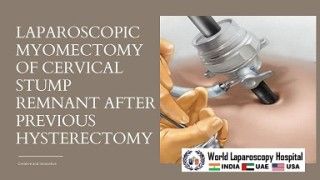Visualize the Unseen: How Infrared Imaging Enhances Laparoscopic Surgery
Add to
Share
1,225 views
Report
2 years ago
Description
Infrared imaging has revolutionized laparoscopic surgery by allowing surgeons to see beyond what is visible to the naked eye. By detecting infrared radiation emitted by tissues, this technique provides real-time visualization of blood vessels, nerves, and other structures that are otherwise hidden from view. Infrared imaging enhances the precision and accuracy of laparoscopic surgery, reducing the risk of complications and improving patient outcomes. Join us to learn more about the use of infrared imaging in laparoscopic surgery and how it is transforming the field of minimally invasive surgery. Infrared imaging has become an important tool in laparoscopic surgery, allowing surgeons to visualize tissue and blood flow that would otherwise be unseen. This advanced technology enhances the precision and safety of laparoscopic procedures, enabling surgeons to identify potential complications before they become serious. Learn how infrared imaging is transforming the field of laparoscopic surgery and improving patient outcomes. Infrared imaging technology has revolutionized the field of laparoscopic surgery by providing real-time visualization of tissues and blood vessels that are not visible to the naked eye. This non-invasive technique allows surgeons to identify critical structures and avoid inadvertent injury during surgery, which enhances patient safety and reduces the risk of complications. The use of infrared imaging has become increasingly common in laparoscopic surgery, especially in procedures such as liver resection, gastric bypass surgery, and vascular surgery. The technology works by detecting infrared radiation emitted by the tissues and blood vessels, which is then converted into an image that can be viewed by the surgeon on a monitor. One of the key advantages of infrared imaging is its ability to provide high-resolution images in real-time, which allows the surgeon to make accurate and precise incisions. This reduces the risk of bleeding and tissue damage, which in turn minimizes the patient's pain and post-operative recovery time. Furthermore, infrared imaging can also be used to identify areas of the tissue that may be poorly perfused or have reduced blood flow, which can be an indication of cancer or other diseases. This allows the surgeon to make more informed decisions about the extent of the surgery required and the optimal approach to take. In summary, the use of infrared imaging in laparoscopic surgery is a significant advancement that improves patient outcomes and enhances the overall quality of surgical procedures. Its use is becoming increasingly common and is expected to continue to play a vital role in the future of minimally invasive surgery. Infrared imaging is a cutting-edge technology that has revolutionized laparoscopic surgery. It allows surgeons to visualize structures that are normally invisible to the naked eye, such as blood vessels and bile ducts. This technique involves using an infrared camera to capture images of the surgical field, which are then displayed on a monitor. The camera can detect the heat emitted by different tissues, allowing the surgeon to differentiate between them and make more precise incisions. The use of infrared imaging in laparoscopic surgery has several advantages, including reducing the risk of injury to vital structures and minimizing blood loss. It also improves the accuracy and efficiency of the procedure, resulting in better patient outcomes and shorter recovery times. If you're considering laparoscopic surgery, it's important to choose a surgeon who has experience using infrared imaging. At our institute, we are committed to using the latest technologies and techniques to provide our patients with the highest quality care. Contact us to learn more about how infrared imaging can improve your surgical experience.
Similar Videos






